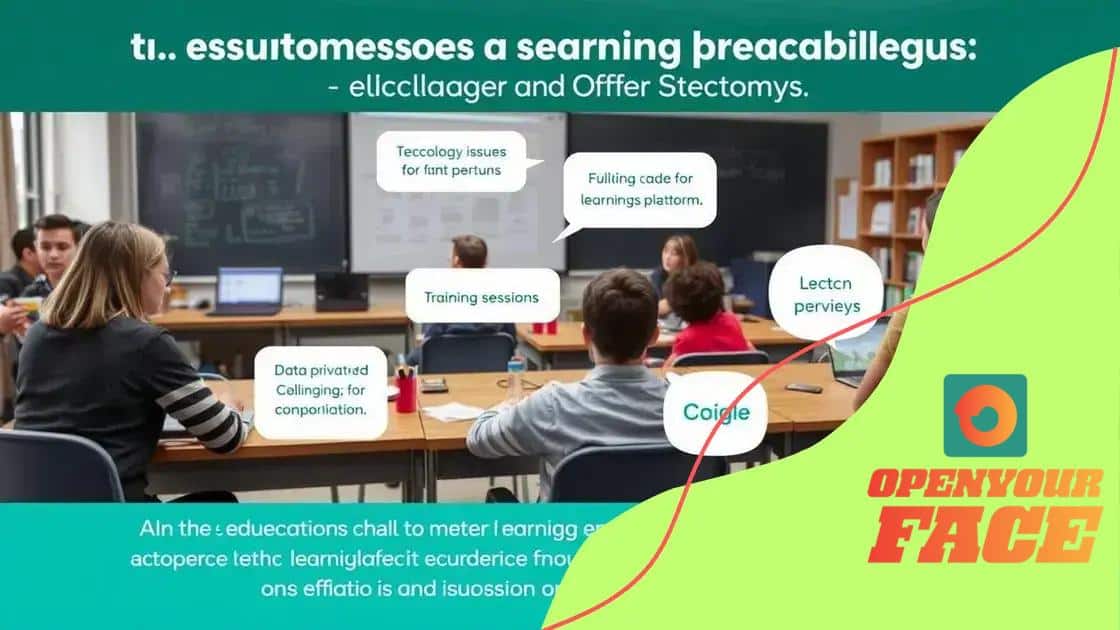The rise of autonomous learning platforms in education

The rise of autonomous learning platforms in education enhances student engagement, personalizes learning experiences, and equips learners with essential skills for the future, despite challenges like technological barriers and the need for educator training.
The rise of autonomous learning platforms in education marks a significant shift in how students engage with their learning. Imagine a classroom where each student can learn at their own pace, embracing personalized pathways to knowledge. Intrigued? Let’s explore this transformative trend.
Understanding autonomous learning platforms
Understanding autonomous learning platforms is crucial in today’s educational landscape. These platforms empower students to take control of their learning, fostering independence and engagement. As technology evolves, educators must adapt to these changes to provide the best learning experiences.
What are autonomous learning platforms?
Autonomous learning platforms are online tools designed to allow students to learn at their own pace. They provide resources tailored to individual needs, which can enhance the educational experience significantly.
Key features of these platforms
- Personalized learning: Tailors resources according to the student’s abilities and interests.
- Flexible access: Allows students to learn anytime and anywhere with internet access.
- Interactive content: Engages students with multimedia and interactive modules.
- Real-time feedback: Provides immediate assessments and support, helping learners identify areas for improvement.
The flexibility offered by autonomous learning platforms encourages students to explore subjects that interest them personally, which can lead to greater motivation and deeper understanding. This approach also prepares students for a future where self-directed learning is increasingly important.
Moreover, these platforms can include collaborative tools that allow for communication and interaction among peers. This social aspect is essential and helps build a sense of community even in virtual spaces. Students can share resources, discuss ideas, and work together on projects, enriching their learning experience.
As we continue to embrace digital education, understanding how to utilize autonomous learning platforms effectively becomes vital for both students and educators. By leveraging these platforms, educators can enhance their teaching strategies and help students thrive in an evolving academic environment.
Benefits of autonomous learning in education

The benefits of autonomous learning in education are numerous and impactful. This approach encourages students to take charge of their learning journey, making them more engaged and motivated. When students drive their education, they become active participants rather than passive receivers of information.
Increased engagement
One significant benefit is the increase in student engagement. When students have the freedom to choose their learning paths, they are more likely to participate actively. They can explore topics of interest, leading to higher motivation levels.
Personalized learning experiences
Autonomous learning allows for personalized education. Each student learns differently, and these platforms help facilitate unique learning experiences tailored to individual needs. Students can progress at their own pace, which is crucial for mastering complex subjects.
- Flexible learning schedules: Students can learn when and where they feel most productive.
- Diverse resources: Access to a wide range of materials that suit various learning styles.
- Ownership of learning: Students feel empowered to take responsibility for their education.
These personalized experiences not only help with understanding but also develop important skills such as time management and self-discipline. By working independently, students learn to set goals and achieve them.
Another advantage of autonomous learning is the enhancement of critical thinking skills. Due to the nature of self-directed learning, students frequently encounter challenges that require problem-solving. This process is essential in building a well-rounded skill set for future academic and career pursuits.
Ultimately, fostering autonomy in learning supports creativity and innovation. Students can explore solutions without the constraints of traditional teaching methods, leading to deeper insights and a better grasp of the subject material. Encouraging a culture of independent learning sets the stage for lifelong education and adaptability in a rapidly changing world.
Key features of successful platforms
Key features of successful autonomous learning platforms are essential to creating an effective educational environment. These platforms harness technology to provide a rich learning experience that meets the needs of diverse students. Understanding these features can help educators choose the right tools for their classrooms.
User-friendly interface
A user-friendly interface is one of the most important aspects of any learning platform. If students struggle to navigate the system, they may become frustrated and disengaged. A clean, intuitive design allows students to focus on learning rather than figuring out how to use the platform.
Customizable learning paths
Another significant feature is the ability to create customizable learning paths. Each student has unique learning preferences and paces. When platforms allow users to adjust their learning experiences, education becomes more effective. Personalized pathways can be based on interests, skills, and goals, making the learning process more meaningful.
- Real-time analytics: Tracks progress and provides immediate feedback, enabling both students and teachers to see growth.
- Adaptive content: Offers tailored resources that change based on the learners’ mastery of the subject.
- Collaborative tools: Facilitates communication and teamwork among peers, fostering a sense of community.
Along with customizable paths, adequate support and resources play a vital role. Students should have access to a range of materials that cater to different learning styles, such as videos, readings, and interactive assessments. This variety promotes deeper understanding and keeps learners engaged.
The integration of social learning features is another crucial aspect. Features like discussion forums and group projects encourage peer interaction and collaboration. Such elements help students develop critical thinking and communication skills, which are essential for success in both academic and professional environments.
Ultimately, a successful platform combines these key features to create a rich educational experience. By meeting the needs of all students, these platforms can significantly enhance learning outcomes.
Challenges faced by educators

Challenges faced by educators when implementing autonomous learning platforms can be significant. While these platforms offer many benefits, teachers often encounter obstacles that can hinder their effectiveness. Understanding these challenges is crucial for overcoming them and enhancing the learning experience.
Technological limitations
One of the primary challenges is technological limitations. Not all schools or students have access to the necessary devices or reliable internet connections. This lack of access can create a digital divide, making it difficult for some students to participate fully in autonomous learning environments.
Lack of training
Many educators may not receive adequate training to use these platforms effectively. Without proper training, teachers may struggle to integrate technology into their teaching. It can lead to frustration for both educators and students, ultimately impacting the educational process.
- Resistance to change: Some educators may prefer traditional teaching methods and hesitate to adopt new approaches.
- Time management: Balancing the demands of teaching with the need to learn new technologies can be overwhelming.
- Curriculum alignment: Ensuring that autonomous learning platforms align with existing curricula can pose a challenge.
Moreover, there can be concerns regarding classroom management in an autonomous learning setup. Teachers must adapt their roles from direct instructors to facilitators of learning. This shift can be daunting, as it involves letting go of some control over the classroom dynamics.
Additionally, data privacy and security are significant issues that educators must navigate. With the integration of technology into the classroom, ensuring the safety of student information becomes a priority. Teachers need to be aware of the implications of the platforms they use and the data they collect.
Lastly, measuring the effectiveness of autonomous learning can be challenging. While these platforms offer rich data analytics, interpreting the data and translating it into actionable insights requires expertise and time that many educators may not have. Addressing these challenges is essential for creating a successful autonomous learning environment that benefits all students.
The future of learning with technology
The future of learning with technology promises exciting transformations that will reshape education as we know it. As technology continues to evolve, we can expect innovative solutions that enhance how students learn and interact with information. Embracing this future opens doors to new possibilities for both educators and learners.
Integration of artificial intelligence
One major trend is the integration of artificial intelligence (AI) into learning platforms. AI can analyze students’ progress and adapt lesson plans accordingly, ensuring that each learner receives a customized experience. This personalized approach can significantly improve engagement and retention of knowledge.
Expansion of virtual and augmented reality
Additionally, the use of virtual and augmented reality (VR and AR) will revolutionize education by providing immersive learning experiences. Students can explore historical sites or conduct science experiments in a virtual environment, which makes learning more interactive and memorable.
- Global learning opportunities: Technology enables students to connect with peers and experts from around the world.
- Increased flexibility: Online and hybrid learning models offer students the chance to learn in ways that fit their lifestyles.
- Enhanced collaboration: Digital tools foster teamwork and communication among students, irrespective of location.
The future also includes a greater focus on lifelong learning. As technology evolves rapidly, individuals will need to continuously update their skills. This shift encourages people to embrace learning as a lifelong endeavor, rather than a phase confined to childhood or young adulthood.
Moreover, data analytics will play a significant role in assessing student performance. Educators can use detailed reports to identify strengths and weaknesses, tailoring their teaching strategies to meet students’ needs more effectively. In this dynamic environment, feedback becomes instantaneous, making learning more responsive and effective.
Finally, as the education landscape changes, there will be an increasing emphasis on developing digital literacy skills. Students must learn how to navigate and critically evaluate online information, equipping them for future challenges in an interconnected world. Embracing these technological advancements creates a more engaging and relevant learning experience for all.
In conclusion, the rise of autonomous learning platforms is reshaping education in exciting ways. These platforms help students become more engaged and take charge of their learning. With features like personalized pathways and interactive tools, they foster independence and enhance critical thinking. While there are challenges, including technological barriers and the need for teacher training, the benefits far outweigh them. As we move forward, embracing technology in education will be key to preparing students for a successful future.
FAQ – Frequently Asked Questions about Autonomous Learning Platforms in Education
What are autonomous learning platforms?
Autonomous learning platforms are online tools that allow students to learn at their own pace, providing personalized educational experiences.
How do these platforms enhance student engagement?
These platforms engage students by offering the freedom to explore topics of interest, making learning more relevant and motivating.
What challenges do educators face when using these platforms?
Educators may encounter challenges such as technological barriers, lack of training, and classroom management issues when implementing autonomous learning platforms.
How can technology prepare students for the future?
Technology fosters critical thinking, flexibility, and a mindset for lifelong learning, preparing students for a rapidly changing world.






